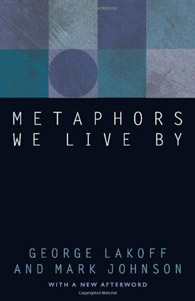Chapters 9 and 10 look at groups of metaphors and cognitive coherence. For example, the metaphor »time« at first appears incoherent in these examples: as we go further into the 1980s, we’re approaching the end of the year. Yet at closer look we see that the two examples are subcases of the metaphor: time passes us—from front to back. Case one: time is a moving object and moves toward us, and case two: time is stationary and we move in the direction of the future. The next three examples also seem to be a mixed group: It’s been a long, bumpy road, our marriage is on the rocks, we’ve gotten off the track. These three examples are again subcases for the metaphor: love is a journey, and the metaphor remains coherent whether the journey is in a car, boat or train.
Chapters 14 and 15 not only look at causation, but at how people form and structure their concepts. For example Lakoff and Johnson reference the term »prototype« from Eleanor Rosch[2] (For designers the term »archetype« may be more appropriate) as the central or defining member of a category. »Her experiments indicate that people categorize objects not in set theoretical terms, but in terms of prototypes and family resemblances. For example, small flying singing birds, like sparrows, robins etc., are prototypical birds. Chickens, ostriches, and penguins are birds but are not central members of the category—they are nonprototypical birds.« (p. 71) This idea is central to how we form, identify and use metaphorical concepts. There are prototypical experiences that form the core of the metaphor and then similar experiences organized in relation to the core. Chapter 15 introduces the term »natural dimension of experience« as a way of showing how concepts fit to experience. Natural dimensions are recurring features of an experience that we use to define them. In their words: »The concept (say, conversation) specifies certain natural dimensions (e.g., participants, parts, stages, etc.) and how these dimensions are related. There is a correlation, dimension by dimension, between the concept conversation and the aspects of the actual activity of conversing.« (p. 83). Here we have the idea of how we use characteristic features of experiences to identify them as distinct concepts. A conversation, for example, involves (has the characteristic features of) at least two people (participants) taking turns talking, with the intention of reaching mutual understanding. Some of these concepts are easily observed with objects, environments or activities. »Domains of experience that are organized as gestalts in terms of such natural dimensions seem to us to be natural kinds of experience. They are natural in the following sense: These kinds of experiences are a product of: Our bodies … our interactions with our physical environment … Our interactions with other people within our culture …« (p. 117) Furthermore certain abstract concepts like love, time or understanding are almost always understood or defined in terms of more direct or natural concepts, hence metaphorically. Rather than seeing these categories as fixed the authors see them as experience based and open ended.
Lakoff and Johnson also link the form of expressions to meaning: »For example the conduit metaphor defines a spatial relationship between form and content … When we see actual containers that are small we expect their contents to be small. When we see actual containers that are large, we normally expect their contents to be large. Applying this to the conduit metaphor, we get the expectation: more of form is more of content.« (chapter 20, p. 127) The authors then give many illustrative examples: »He ran and ran and ran and ran is more running than he ran.… Saying: He is bi-i-i-i-ig! indicates that he is bigger than you indicate when you say just: He is big.« (p. 127–8)
In the last chapters of the book, the authors continue to anchor their arguments in the way we structure concepts based on our experience in terms of causation, coherence and truth. What seem to be a straightforward ideas challenge certain traditions in western philosophy and linguistics. Lakoff and Johnson build a careful and thoughtful case for their position and illustrate their points with many vivid and revealing examples.

